Discover the majesty of the 7-Colored Mountain in Peru, also known as Vinicunca or Rainbow Mountain, a destination that feels like a surrealist dream. With its stunning shades of red, green, yellow, purple, and blue, this captivating place invites you to experience a one-of-a-kind adventure in the Andes. If you’re planning your next trip for 2025, don’t miss the chance to explore this magical corner that combines natural beauty and thrilling adventure, making it one of the world’s most spectacular and photogenic destinations. Prepare to walk on a rainbow and create unforgettable memories in this Andean paradise.
- Important and Fascinating Facts About Rainbow Mountain (Vinicunca)
- Location and Altitude of the Rainbow Mountain
- Climate of the Rainbow Mountain – Vinicunca
- Unique Biodiversity
- Fascinating Facts That Will Amaze You
- Challenges for Visitors
- What Are the 3 Routes to the Rainbow Mountain?
- How to Get to the Rainbow Mountain?
- What to Bring to the Rainbow Mountain? Get Ready for the Adventure!
- Frequently Asked Questions:
- You might be interested in:
Important and Fascinating Facts About Rainbow Mountain (Vinicunca)
Origin of Its Colors
The 7-Colored Mountain is a visual spectacle and an open book of Earth’s history. Each layer of minerals represents a distinct geological era, and its current exposure results from millions of years of tectonic movements and erosion. For geology enthusiasts, Vinicunca is a captivating destination that blends beauty and science.
Geological Formation: Vinicunca formed during the Cretaceous period, approximately 75 to 63 million years ago (Campanian – Lower Paleocene). During this time, the region experienced intense tectonic and volcanic activity, creating sedimentary layers rich in minerals. Over millions of years, these layers’ erosion and exposure have unveiled the spectacular geological rainbow we see today.
The 7-Colored Mountain owes its vibrant appearance to a complex mixture of minerals that have interacted over millions of years. Each hue tells a unique geological story:
| Mineralogical Composition: A Rainbow on Earth | |
| Pink or Fuchsia: | This color results from red clay, mudstone, and sand. These sedimentary layers formed in environments rich in iron and magnesium. |
| Green: | The green hue comes from ferro-magnesian-rich clays combined with copper oxide. These minerals indicate the presence of ancient volcanic deposits. |
| Red: | The intense red color is due to iron-rich argillites and clays. These layers formed under oxidizing conditions. |
| Whitish: | This color originates from sandstone, composed mainly of quartz and limestone, which reflect light uniquely. |
| Yellow: | Limonite and calcareous sandstone rich in sulfured minerals create a yellow tone. These minerals contain sulfur, which contributes to their coloration. |
| Purple or Lavender: | This shade results from marl, a mixture of clay, calcium carbonate, and silicates. These layers formed in shallow marine environments. |
Recent Discovery: Although the mountain has existed for millions of years, its popularity as a tourist destination began around 2015 when glacial melting revealed its hidden colors.

The Cultural and Spiritual Significance of Vinicunca
The Mountain of 7 Colors is far more than a tourist attraction for local communities. It is a sacred site that embodies the connection with Pachamama (Mother Earth). The guardians of the mountain protect this natural treasure and share with visitors the traditions and legends passed down from generation to generation. This majestic place captivates with its vibrant beauty and serves as a spiritual bridge between the past and the present, honoring the deep-rooted heritage of the Andean people. By preserving its cultural essence, Vinicunca is a testament to the harmonious relationship between humanity and nature.
Location and Altitude of the Rainbow Mountain
Nestled in the heart of the majestic Peruvian Andes, within the department of Cusco, lies a place that has emerged from a dream: the Rainbow Mountain. Situated on the territorial boundary between the provinces of Quispicanchi and Canchis, this breathtaking destination rises to an impressive altitude of 5,200 meters above sea level. Its vibrant, multicolored slopes and awe-inspiring elevation make it a must-visit landmark for adventurers and nature enthusiasts, offering a unique glimpse into the natural wonders of the Andes.
Climate of the Rainbow Mountain – Vinicunca
The climate in Vinicunca is cold and unpredictable due to its high altitude. Below, we outline the two main seasons to help you plan your visit:
- Rainy Season (November to March):
During these months, frequent rainfall makes access challenging and trails more slippery. However, the landscape becomes greener and less crowded. The mountain is often shrouded in mist, adding a mystical touch to the scenery. Temperatures are similar to those in the dry season but with higher humidity. It is not advisable to visit without checking the weather forecast beforehand. - Dry Season (April to October):
This season is the best time to visit the Rainbow Mountain. Days are sunny, rainfall is scarce, and trekking becomes more accessible, offering clear and breathtaking views. Daytime temperatures range between 10°C and 15°C, but at night, they can drop to as low as -5°C. This season provides optimal conditions for exploring and fully appreciating the vibrant beauty of Vinicunca.
Unique Biodiversity
- Flora and Fauna:
Despite the extreme conditions, the area is home to species uniquely adapted to high altitudes, such as vicuñas, alpacas, and llamas. You will also find ichu, a resilient grass that thrives in the Andean highlands. These species contribute to the region’s rich biodiversity, showcasing nature’s ability to adapt and flourish in challenging environments. - Surrounding Landscapes:
Beyond the mountain, you can explore various stunning natural wonders, including turquoise lagoons, red valleys, and majestic glaciers.
Fascinating Facts That Will Amaze You
- It Wasn’t Always Famous:
Although Rainbow Mountain is now a global tourist icon, it was virtually unknown until a decade ago. Tourism has grown exponentially, attracting travelers from all around the world eager to witness its surreal beauty. - Perfect Photography Opportunity:
The mountain’s colors appear most vibrant on sunny days, particularly during the early morning hours. This is the ideal time to capture stunning, postcard-worthy photographs that showcase its unique palette. - Environmental Preservation Efforts:
Due to the surge in tourism, protective measures have been implemented to safeguard the mountain. These include designated trails and vehicle restrictions in certain areas, ensuring the preservation of this natural wonder for future generations.
Did You Know?
Artistic Inspiration:
The vibrant colors of Vinicunca have inspired artists, photographers, and travelers alike. They symbolize Peru’s unparalleled natural beauty. Its striking hues and dramatic landscapes have become a muse for global creative minds.
It’s Not the Only One:
While Vinicunca is the most famous, other colorful mountains exist worldwide, such as Zhangye Danxia in China and the Hill of Seven Colors in Argentina. However, Vinicunca stands out for its unique combination of tones and breathtaking Andean setting, offering a unique experience that captivates all who visit.
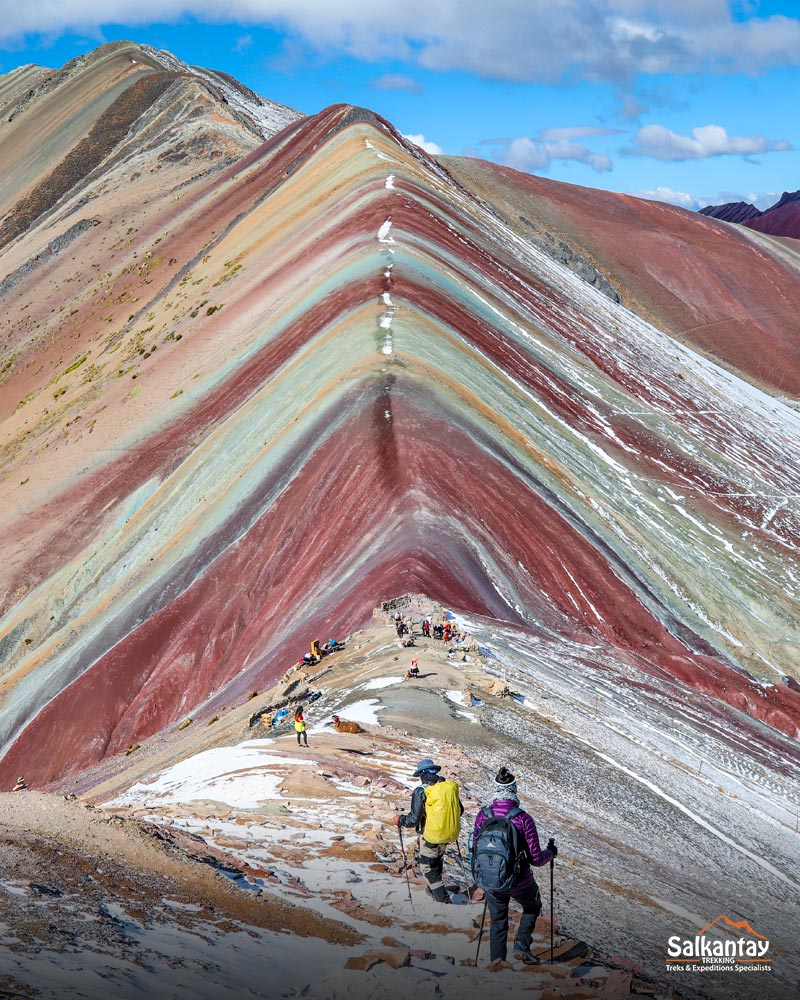


Challenges for Visitors
- Altitude Sickness:
People who are not acclimatized may feel the effects of the high altitude. It is highly recommended that you spend at least two days in Cusco before attempting the trek to allow your body to adjust and reduce the risk of altitude-related issues. - Physical Effort:
The hike is considered moderate, but the combination of high altitude and uneven terrain can make it more demanding. Proper preparation, including physical conditioning and adequate hydration, ensures a safe and enjoyable experience.
Always Remember:
You can rent horses if the climb to the summit feels too challenging. However, before making that decision, we invite you to reflect: these noble animals are not mere tools but living beings that deserve our respect and care. That’s why we appeal to your conscience and adventurous spirit: choose to walk not just for yourself but for those loyal four-legged companions who deserve a break. The summit will be your reward, but the journey will be your greatest triumph.
What Are the 3 Routes to the Rainbow Mountain?
The Rainbow Mountain, also known as Vinicunca, is one of Peru’s most captivating destinations. Its vibrant colored stripes and breathtaking natural surroundings attract travelers from around the globe. If you plan to visit this wonder, you should know there are three main routes to reach it: Checacupe – Pitumarca, Cusipata, and Ausangate. This article breaks down each route so you can choose the one that best suits your travel style.
1. Checacupe – Pitumarca Route: For Adventure Enthusiasts
Distance and Hiking Time
- Distance: 8 km (round trip) from Kayrawiri to Vinicunca.
- Time: Approximately 2 hours and 30 minutes (one way).
Advantages
- Less Crowded: This route is perfect for those looking to avoid crowds and enjoy a more peaceful journey.
- Unique Landscapes: Along the way, you’ll witness stunning Andean scenery and feel a deep connection with nature.
Disadvantages
- Longer Bus Ride: The public transportation journey from Cusco is longer compared to other routes.
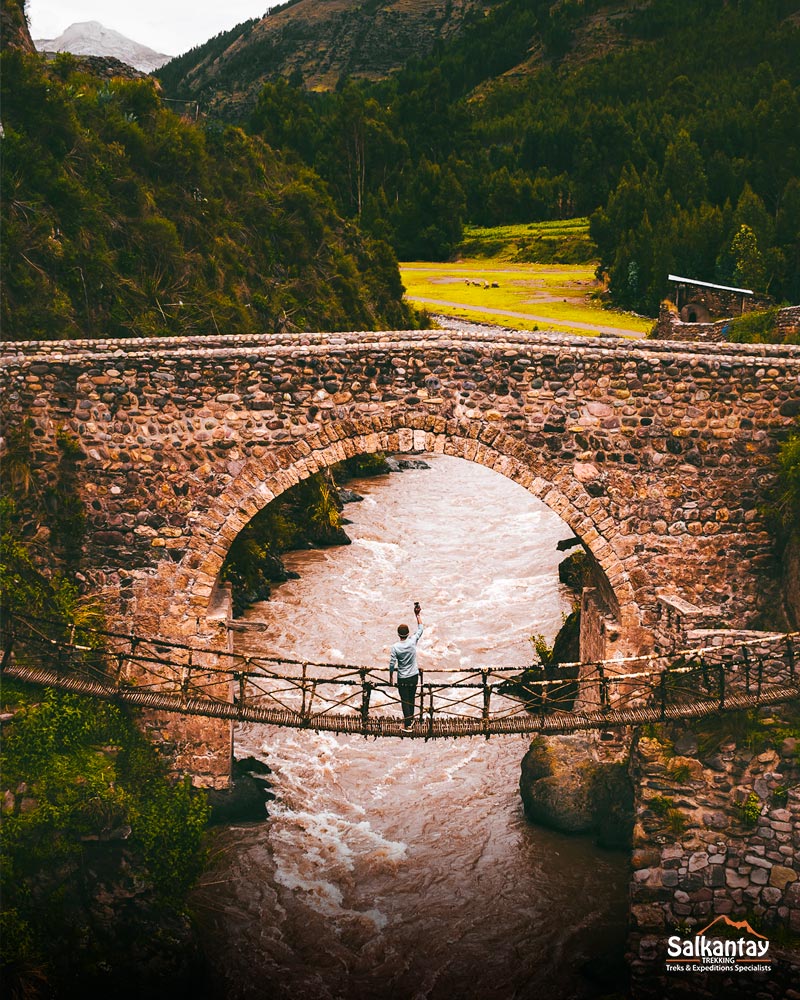
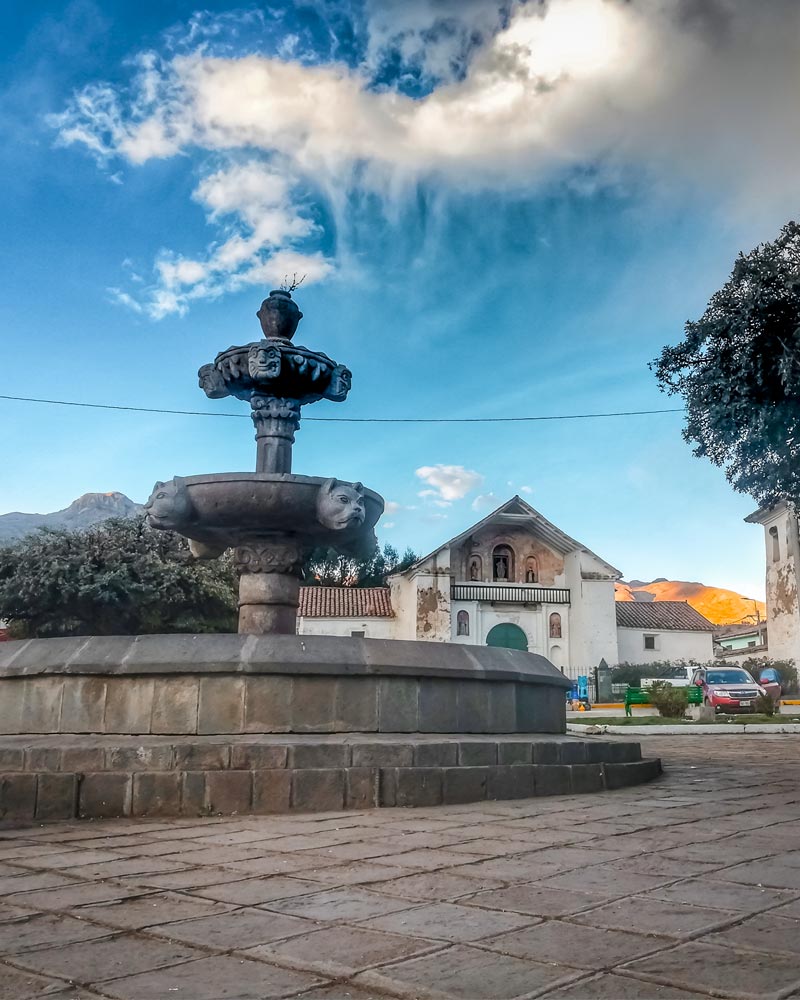
2. Cusipata Route: The Most Popular Option
Distance and Hiking Time
- Distance: 7 km (round trip) from Phulawasipata to Vinicunca.
- Time: Approximately 1 hour and 30 minutes (one way).
Advantages
- Accessibility: This is the most commonly used route by tourists, making it easy to find organized tours and services.
- Red Valley: Along the way, you’ll have the opportunity to visit the famous Red Valley, a place brimming with natural beauty.
Disadvantages
- Crowds: As the most popular route, it can get crowded, especially during peak season.

3. Ausangate Route: For the Most Adventurous
Distance and Hiking Time
- Distance: 15 km trek.
- Time: 4 days and 3 nights (this is a trekking route).
Advantages
- Unique Experience: This route is perfect for trekking and adventure enthusiasts.
- Pure Nature: You’ll be in direct contact with nature and can enjoy breathtaking landscapes, including Rainbow Mountain and the majestic Ausangate Snowy Peak.
- Less Crowded: It’s a less-traveled route, ideal for those seeking a more authentic experience away from mass tourism.
Disadvantages
- Physical Demand: The trek is long and challenging due to the altitude and duration of the journey.
- Acclimatization Required: Before starting this route, proper acclimatization in Cusco is essential to avoid altitude sickness.

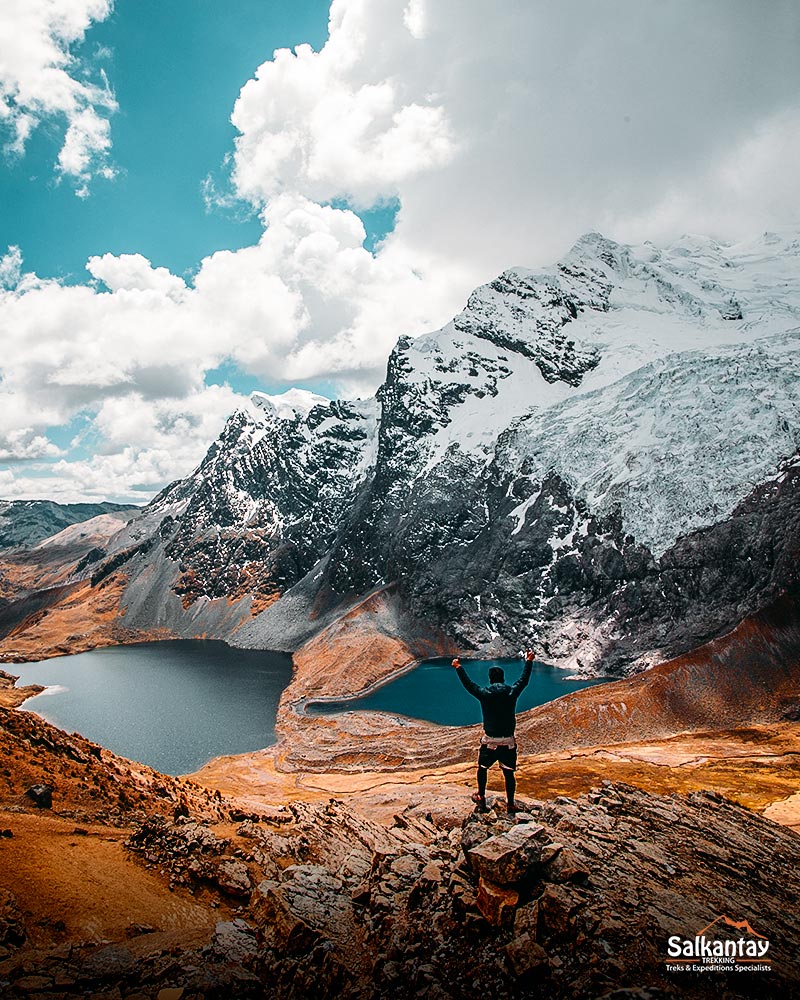
How to Get to the Rainbow Mountain?
With a Tour (The Most Recommended Option):
If you’re looking for comfort, safety, and a worry-free experience, booking an organized tour is the best way to visit the Mountain of Seven Colors (Vinicunca). At Salkantay Trekking, we take care of every detail so you can focus solely on enjoying this natural wonder to the fullest. Here’s why choosing a tour is the ideal decision for your adventure.
- Total Comfort: We Handle Everything
Imagine a trip where your only concern is walking and soaking in the scenery. With our tours, that’s precisely what you get. We take care of:- Transportation: Pick-up from your hotel in Cusco and round-trip transfer to Vinicunca in private, comfortable vehicles.
- Professional Guide: Our expert guides, well-versed in local culture and geography, will accompany you at all times and share fascinating insights about the mountain and its surroundings.
- Permits: We manage all necessary paperwork for your entry to Rainbow Mountain.
- Lunch: A delicious box lunch is included to recharge your energy after the hike.
- Benefits of Traveling with an Organized Tour
- Safety: Traveling with a tour ensures you have an expert team that knows the route and is prepared for any situation.
- Time-Saving: No need to worry about organizing transportation, buying tickets, or negotiating with taxi drivers. The package includes everything.
- Convenience: Forget about logistical hassles. We handle all the details so you can simply enjoy.
- Cultural Connection: Our guides take you to the mountain and share fascinating stories and facts about Andean culture and Vinicunca’s unique geology.
- Variety of Options: A Tour for Every Traveler
At Rainbow Mountain, we have the perfect experience for you. We understand that every traveler is unique, so we’ve designed various tours tailored to your needs, budget, and experience level.
| Hiking Options | Duration | Description |
| Rainbow Mountain Peru 1-Day Tour | 1 Day | The Rainbow Mountain, also known as Vinicunca, is one of Peru’s most captivating destinations. Every step in this natural paradise brings you closer to a unique visual spectacle where nature transforms into a masterpiece of art. |
| Ausangate, Rainbow Mountain & Red Valley | 2 Days | Combine your visit to Rainbow Mountain with the stunning Red Valley, a place that feels like it transports you to another planet. This tour offers the best of both worlds: the iconic Vinicunca with its magical hues and the Red Valley, a landscape of rock formations and scenery that contrasts beautifully with the blue sky. |
Do you think the magic of vibrant colors and dreamlike landscapes is limited to just one place?
You’ll be surprised to learn it’s not! Beyond the Rainbow Mountain, we invite you to discover other iconic destinations with the same magical and surreal essence.
Ready to explore further? These places await to offer you a unique and unforgettable experience.
| Hiking Options | Duration | Description |
| Palccoyo Rainbow Mountain 1-Day Tour | 1 Day | If you’re looking for a unique yet more relaxed experience, the Palccoyo Rainbow Mountain is your best option. With a more accessible route than Vinicunca, Palccoyo is ideal for those who want to enjoy the magic of colors without strenuous effort. |
| Pallay Punchu Rainbow Mountain -Tour | 1 Day | For adventurers seeking something extraordinary, Pallay Punchu is a hidden gem you can’t miss. This stunning destination, known as the “younger sibling” of Vinicunca, will amaze you with its layers of colors that stretch out like a giant tapestry woven by nature |
No matter which tour you choose, each is carefully designed to provide you with a unique and memorable adventure. Whether you opt for the iconic Rainbow Mountain – Vinicunca or explore its beautiful variants like Palccoyo or Pallay Punchu, we guarantee that every corner of these destinations will leave you breathless.
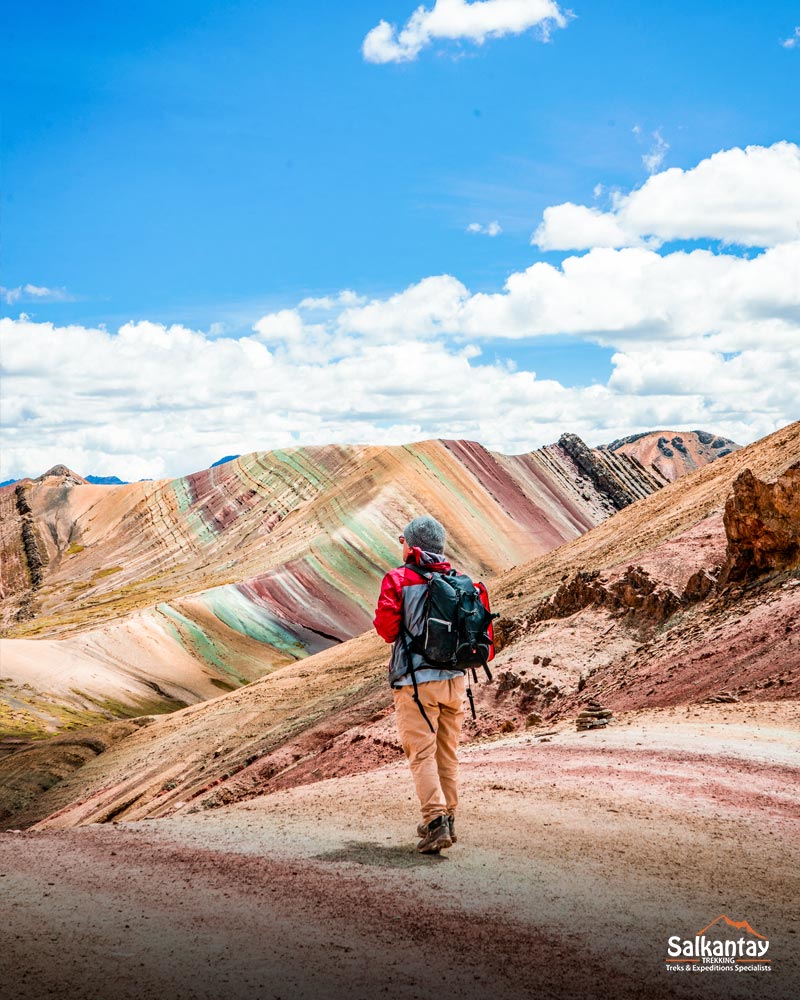


On Your Own (The Least Recommended Option)
If you prefer to travel independently, the route from Pitumarca is an option, though it’s not the most recommended. Here’s how you can do it:
You’ll need to take the Checacupe – Pitumarca route to embark on this journey.
- From Cusco to Checacupe:
- Private Taxi: This is the most comfortable option, with prices ranging between 250 and 350 soles (40-50 USD) per trip. It’s ideal if you’re traveling in a group.
- Public Transportation: Take a bus from Avenida Huayruropata in Cusco to Sicuani. Inform the driver that you’ll be getting off in Checacupe. The cost is 7-8 soles (less than 2 USD), and the journey takes approximately 2 hours.
- From Checacupe to Vinicunca:
- Once in Checacupe, negotiate with local taxi drivers to reach the base of Rainbow Mountain. You can split the approximate cost of 150 soles per car (41 USD) among several people.
- Once in Checacupe, negotiate with local taxi drivers to reach the base of Rainbow Mountain. You can split the approximate cost of 150 soles per car (41 USD) among several people.
- The Hike:
- The round-trip hike takes about 3 hours, with a moderate incline. Don’t forget to bring water, snacks, and sunscreen. Upon arrival, you’ll pay an entrance fee of 25 soles (7 USD) for foreigners and 15 soles (4.50 USD) for Peruvians with a valid ID.
- The round-trip hike takes about 3 hours, with a moderate incline. Don’t forget to bring water, snacks, and sunscreen. Upon arrival, you’ll pay an entrance fee of 25 soles (7 USD) for foreigners and 15 soles (4.50 USD) for Peruvians with a valid ID.
- The Return:
- After the hike, your taxi will take you back to Checacupe, where you can catch a local bus to Cusco.
Disadvantages of Traveling on Your Own:
- Complicated Logistics: You must arrange transportation, negotiate prices, and coordinate schedules.
- Less Safety: Traveling without an expert guide can be risky, especially in remote areas.
- Lack of Information: You might miss out on cultural or historical insights that a professional guide would provide.

What to Bring to the Rainbow Mountain? Get Ready for the Adventure!
Visiting the Rainbow Mountain is a once-in-a-lifetime experience, but it’s essential to come well-prepared to make the most of it. Here’s a detailed list of what you should pack to ensure you’re ready for any situation and can focus on enjoying this incredible destination.
Clothing: The Key to Tackling Changing Weather
- Layered Clothing: The weather on the mountain can change drastically. Start with lightweight clothing for the hike and bring additional layers (like a fleece or thermal jacket) for the summit, where the cold and wind can be intense.
- Waterproof Jacket: Rain or snow can appear unexpectedly. A waterproof jacket will keep you dry and comfortable.
- Hiking Boots: The terrain can be uneven and challenging. Wear sturdy, waterproof boots with good ankle support to protect your feet and ensure stability.
Essential Accessories:
- Water Bottle: Stay hydrated throughout the hike. Opt for a reusable bottle to help protect the environment.
- Sunscreen: AV rays are more potent at higher altitudes. Use a high-SPF sunscreen to protect your skin.
- Sunglasses: Shield your eyes from the sun and wind with quality sunglasses.
- Camera: You won’t want to miss capturing the surreal landscapes of the Rainbow Mountain. Bring your camera or smartphone with enough battery!
- Toilet Paper: An essential item many forget. Bring enough for personal use.
- Small Backpack: A lightweight yet durable backpack is ideal for carrying your essentials during the hike.
- Hat or Cap: Wear a hat or cap to protect your head from the sun during the day and from the cold in the early morning.
- Gloves: Temperatures can drop significantly, especially at the summit. Gloves will keep your hands warm and comfortable.
- Hiking Poles: These are great for maintaining balance, reducing joint strain, and improving your pace during the hike.
Other Must-Have Items:
- Cash: There are no ATMs in the area, so bring enough cash for expenses like food, souvenirs, or tips.
- Snacks: Keep your energy levels up with light, nutritious snacks like dried fruit, energy bars, or nuts.
- Rain Poncho: Lightweight and compact, a poncho will save you from unexpected rain or snow.
- ID Document: Always carry your identification in case of any emergencies.

Extra Tip:
Don’t forget to bring a small backpack to store your belongings, sunglasses to protect your eyes, and a hiking pole if you need extra stability.
Frequently Asked Questions:
- How much does it cost to enter the Rainbow Mountain?
The entrance fee is 25 Peruvian soles (approximately 5 USD). A tour package may include this cost if you decide to book one. - How far is the Rainbow Mountain?
The mountain is about 100 km (62 miles) from the center of Cusco. Depending on traffic and road conditions, the drive takes 3 to 3.5 hours. - Is it worth visiting the Rainbow Mountain?
Absolutely! It’s a unique landscape you won’t find anywhere else. The combination of colors and the majesty of the surroundings make every effort worthwhile. - Will I suffer from altitude sickness at the Rainbow Mountain?
Exceptionally, if you’re not acclimatized, you may feel the effects of altitude. We recommend spending 2–3 days in Cusco before the hike to adjust. Symptoms like fatigue or mild headaches are typical, but you shouldn’t experience serious issues if you take it easy. - How did the Rainbow Mountain get its colors?
The colors are due to minerals like iron sulfide, iron oxide, and magnesium, which have surfaced over centuries due to erosion and climatic changes. Interestingly, the melting snow fully revealed the mountain for the first time. - Do I need travel insurance to visit the Rainbow Mountain?
Yes, experts highly recommend it. Many travel companies require insurance that covers adventure activities. Additionally, in case of a medical emergency, costs in Cusco can be high. - What happens if I can’t reach the summit?
If you feel fatigued, don’t worry. You can rent horses to take you most of the way. However, you must complete the final part of the hike on foot. - Do I need a guide to visit the Rainbow Mountain?
It’s not mandatory but highly recommended. A guide will provide valuable information about the area and ensure a safer experience. Additionally, all tour packages include guided services, making a booking with a travel agency very convenient. - What is the temperature like at Rainbow Mountain?
Due to the altitude and proximity to the Ausangate glacier, temperatures are cool. You’ll warm up during the hike, but the summit can be icy. Bring warm clothing and layers, which you can adjust as needed. - How long does it take to reach the summit of the Rainbow Mountain?
The hike to the summit usually takes between 1.5 and 2 hours, depending on your pace and physical condition. - Do I need to be physically healthy to visit the Rainbow Mountain?
Yes, the hike can be challenging as it involves ascending to high altitudes. It’s advisable to be in good physical condition and take time to acclimatize before starting the hike. - Are there any age restrictions for visiting the Rainbow Mountain?
There’s no strict age restriction, but the hike can be challenging for young children and elderly individuals. It’s recommended that physical conditions be assessed before planning the visit.












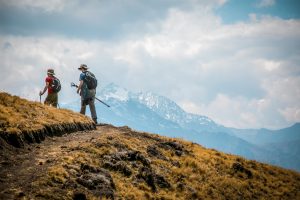

Leave A Reply